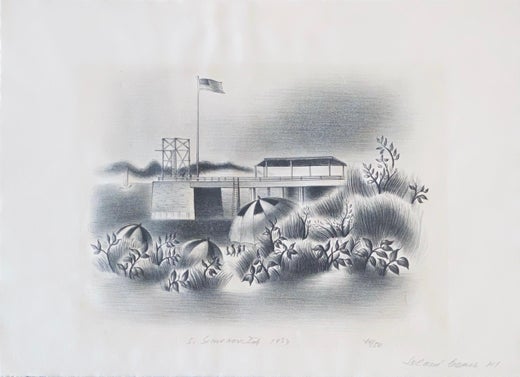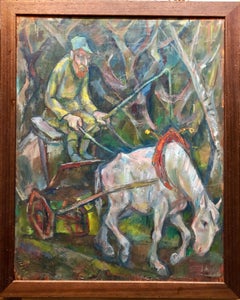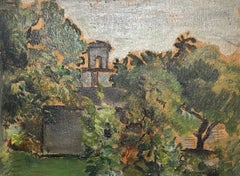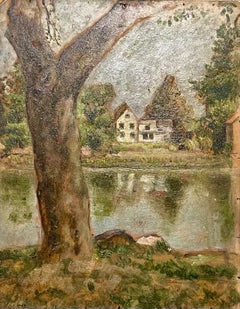Want more images or videos?
Request additional images or videos from the seller
1 of 6
Simka SimkhovitchSimka Simkhovitch WPA Artist Oil Painting American Modernist Landscape Pond Treec.1930's
c.1930's
$1,200List Price
About the Item
- Creator:Simka Simkhovitch (1893 - 1949, Russian, American)
- Creation Year:c.1930's
- Dimensions:Height: 7.75 in (19.69 cm)Width: 6 in (15.24 cm)
- Medium:
- Movement & Style:
- Period:
- Condition:good. minor wear. please see photos.
- Gallery Location:Surfside, FL
- Reference Number:1stDibs: LU38210484882
Simka Simkhovitch
Simka Simkhovitch was born near the city of Kiev, Russia. When he was 7, he spent a year in bed with a severe case of measles. To amuse himself he used to sketch an old mill outside his window, and thus decided to become an artist. He studied at an art school in Odessa and was recommended to attend the Imperial Academy of St. Petersburg (a singular honor in Russia at the time) before the war and revolution. Swept up into the army before he could attend, his work was hung in the Museum of Revolution in Leningrad. He resumed his studies in 1914 and graduated four years later. He was sent to the United States in 1924 to do illustrations for Soviet textbooks. He quickly applied for and gained U.S. citizenship. Simkhovitch integrated with the art world immediately and galleries such as Midtown Galleries and Marie Sterner took him on as part of their stable of artists. He also was employed by the WPA and executed major mural commissions throughout the country. One of his largest commissions was the Mississippi Court House. Life magazine profiled him twice with full-length features on his life here in this country as an artist. When he died at an early age, the Whitney Museum of Art in New York offered to do a retrospective and the widow denied the possibility and simply put his works away in storage. Considered a master draftsman and an adherent of certain classicism, Simkhovitch’s compositions are often built up in a complicated but well-managed counterpoint. But at heart, he is a romanticist preferring the dreamy colors of a Russian fairy tale.
About the Seller
4.9
Platinum Seller
Premium sellers with a 4.7+ rating and 24-hour response times
Established in 1995
1stDibs seller since 2014
1,810 sales on 1stDibs
Typical response time: 1 hour
Authenticity Guarantee
In the unlikely event there’s an issue with an item’s authenticity, contact us within 1 year for a full refund. DetailsMoney-Back Guarantee
If your item is not as described, is damaged in transit, or does not arrive, contact us within 7 days for a full refund. Details24-Hour Cancellation
You have a 24-hour grace period in which to reconsider your purchase, with no questions asked.Vetted Professional Sellers
Our world-class sellers must adhere to strict standards for service and quality, maintaining the integrity of our listings.Price-Match Guarantee
If you find that a seller listed the same item for a lower price elsewhere, we’ll match it.Trusted Global Delivery
Our best-in-class carrier network provides specialized shipping options worldwide, including custom delivery.You May Also Like
Cityscape Mid-20th Century Modern Social Realism American Scene Regionalism WPA
Located in New York, NY
Cityscape Mid-20th Century Modern Social Realism American Scene Regionalism WPA
Samuel Thal (1903 to 1964)
"Cityscene"
12 x 16 inches
Oil on board, c. 1940s
Signed verso
Framed: 19...
Category
1940s American Modern Figurative Paintings
Materials
Board, Oil
"Industrial Cityscape, Chicago" WPA Modernism Mid-Century Cityscape 20th Century
By Aaron Bohrod
Located in New York, NY
"Industrial Cityscape, Chicago" WPA Modernism Mid-Century Cityscape 20th Century
Aaron Bohrod (American 1907 – 1992)
Industrial Cityscape
20 x 16 inches
Oil on board
Signed lower ri...
Category
1930s American Modern Landscape Paintings
Materials
Oil, Board
"Money Lender" WPA American Scene Social Realism Modern Mid 20th Century
By Mervin Jules
Located in New York, NY
"Money Lender" WPA American Scene Social Realism Modernism Mid Century
Mervin M Jules (1912-1994
"The Money Lender"
15 1/2 x 20 1/2 inches
Oil on board, c. 1940s
Signed lower left
F...
Category
1940s American Modern Figurative Paintings
Materials
Oil, Board
A Pair of Modern Impressionist Landscape Oil Paintings Framed Female artist NY
Located in Buffalo, NY
A Pair of Modernist Landscapes by listed female artist Margaret Munro Stratton McLennan.
Margaret was a painter working in the early 20th Century in the Syracuse area. These charmi...
Category
1920s American Modern Landscape Paintings
Materials
Oil, Board
$600 Sale Price
20% Off
H 5 in W 7 in
Original Antique American Landscape Fishing Delaware River Oil Painting Framed
Located in Buffalo, NY
A lovely scene adeptly painted by listed American artist and illustrator Jan Nosek (1876 - 1966) who was active in the late 19th and early 20th Century. This scene created in the ea...
Category
1910s American Modern Landscape Paintings
Materials
Oil, Board
Coney Island, Fourth of July
Located in Los Angeles, CA
Coney Island, Fourth of July, c. 1940s, oil on canvas applied to Masonite, signed upper right, 26 x 21 1/2 inches, presented in its original frame
During the 1930s and 40s, Coney I...
Category
1940s American Modern Figurative Paintings
Materials
Board, Oil, Canvas
American West Mountainscape by Gunnar Anderson
Located in New York, NY
Gunnar Donald Anderson (American, 1927-2022)
Untitled, c. 20th Century
Oil on board
Sight: 11 1/2 x 15 3/4 in.
Framed: 20 1/2 x 24 1/2 x 1 1/4 i...
Category
20th Century American Modern Landscape Paintings
Materials
Oil, Board
$2,300
H 20.5 in W 24.5 in D 1.25 in
Cabin in a Snowy Forest by American artist Elizabeth Dailey
Located in New York, NY
Elizabeth Dailey
Untitled, c. 20th Century
Oil on board
Sight: 19 1/2 x 23 1/2 in.
Framed: 21 x 25 x 1 in.
Signed lower right: Elizabeth Dailey
This lovely painting by an American a...
Category
20th Century American Modern Landscape Paintings
Materials
Oil, Board
$1,000
H 21 in W 25 in D 1 in
Morning Sunrise, Mid Century Laguna Hills Figurative Landscape
Located in Soquel, CA
Beautiful mid century plein air figural landscape of Laguna Niguel, California by an unknown artist (American, 20th Century). The morning sun gli...
Category
1950s American Modern Landscape Paintings
Materials
Canvas, Oil, Cardboard
$719 Sale Price
20% Off
H 20 in W 24 in D 2 in
Night Life in the City - Figurative Cityscape
Located in Soquel, CA
Night Life in the City - Figurative Cityscape
Mid 1960s cityscape by an unknown artist. Oil on artists board.
Image, 16"H x 20"W
Category
1960s American Modern Figurative Paintings
Materials
Canvas, Oil, Illustration Board
More From This Seller
View AllLarge Modernist Oil Painting 1940s, Judaica Hasidic Shtetl Wagon Driver WPA Era
By Emanuel Glicenstein Romano
Located in Surfside, FL
Genre: Modern
Subject: Landscape with figure of horse, driver and wagon
Medium: Oil
Surface: wood Board
Hand signed lower middle E.Romano
EMANUEL ROMANO
Rome, Italy, b. 1897, d. 1984
Emanuel Glicen Romano was born in Rome, September 23, 1897.
His father Henryk Glicenstein was a sculptor and was living in Rome with his wife Helena (born Hirszenberg) when Emanuel was born. His father obtained Italian citizenship and adopted the name Enrico. Emanuel was brought up in Italy, Switzerland, Germany, England and Poland.
In 1926 Emanuel Glicenstein Romano and his father sailed for New York. They briefly visited Chicago. Romano's sister, Beatrice, and mother only joined them in New York years later.
Romano changed his name on his arrival to America and some have erroneously speculated that this was to avoid antisemitic discrimination. In truth, as the son of a highly-regarded artist, Romano changed his name to ensure that any success or recognition he would later attain, would be the result of nothing other than his own merit as an artist, and not on account of his father's fame.
In 1936 Romano was worked for the WPA Federal Art Project creating murals. ( there were many jewish artists active with in the WPA period. notably Chaim Gross, Ben Shahn, Isaac and Moses Soyer, Abraham Rattner and many others. During and immediately after World War II, Romano created a series of allegorical works depicting graphic holocaust images that were held closely by the family until after his passing. One of these works is now on permanent display in the Florida Holocaust Museum in St. Petersburg Florida.
Emanuel's father died in 1942 in a car accident before they could realize their shared dream of visiting Israel.
In 1944 Romano, having completed his degree at the Pennsylvania Academy of Fine Arts and the Art Institute of Chicago, began teaching at the City College of New York.
Romano moved to Safed, Israel in 1953 and established an art museum in his father's memory, the Glicenstein Museum.
COLLECTIONS
Indianapolis Museum of Art
Metropolitan Museum of Art
Boston Fine Arts Museum
Fogg Museum
Musée Nacional de France
Recently his work has been added to the Florida Holocaust Museum collection. His notable works include his holocaust themed allegorical paintings as well as portraits of Marianne Moore, his father and William Carlos Williams...
Category
1930s American Modern Figurative Paintings
Materials
Oil, Board
1972 Gestural Oil Painting Boat in Harbor Figural Abstraction Raoul Middleman
By Raoul Middleman
Located in Surfside, FL
Raoul Middleman (born 1935 in Baltimore, Maryland) is an American painter. Middleman has been a member of the Maryland Institute College of Art faculty since 1961. American University Museum at the Katzen Center has described Middleman as a "Baltimore maestro [whose] nudes are not pretty—they are sagging, dimpled, and real. His cityscapes reveal the underbelly of post-industrial rot, his narrative paintings give contemporary life to his personal obsessions. They are intelligent, messy, and utterly masterful."
From an interview with RM "I was doing abstract art. Then Roy Lichtenstein came around, and I wanted to be current. I remember Grace Hartigan said, “You’ve gotta go to New York, seize destiny by the hand.” My friend Jon Schueler took my slides up to Eleanor Ward, who had the Stable Gallery. My Pop art paintings were discovered. I moved to New York into Malcolm Morley’s old loft down on South Street. Agnes Martin was upstairs... People who interest me come from different quarters. I knew guys around Schueler, like B.H. Friedman. But I also knew the Pop world pretty well – Al Hansen, Richard Artschwager, Lichtenstein. I became friends with Raoul Hague...
Category
1970s American Modern Landscape Paintings
Materials
Oil, Board
Simka Simkhovitch WPA Artist Oil Painting American Modernist Landscape w Tower
By Simka Simkhovitch
Located in Surfside, FL
Simka Simkhovitch (Russian/American 1893 - 1949)
This came with a small grouping from the artist's family, some were hand signed some were not.
These were studies for larger paintin...
Category
1930s American Modern Landscape Paintings
Materials
Oil, Board
Simka Simkhovitch WPA Artist Oil Painting American Modernist Landscape Pond Tree
By Simka Simkhovitch
Located in Surfside, FL
Simka Simkhovitch (Russian/American 1893 - 1949)
This came with a small grouping from the artist's family, some were hand signed some were not.
These were studies for larger paintin...
Category
1930s American Modern Landscape Paintings
Materials
Oil, Board
Simka Simkhovitch WPA Artist Oil Painting Gouache American Modernist Powerline
By Simka Simkhovitch
Located in Surfside, FL
Simka Simkhovitch (Russian/American 1893 - 1949)
This came with a small grouping from the artist's family, some were hand signed some were not.
These were studies for larger paintin...
Category
1930s American Modern Landscape Paintings
Materials
Oil, Gouache, Board
Bathers at the Quarry 1940s American Modernist Oil Painting WPA era
By Theresa Berney Loew
Located in Surfside, FL
Swimmers and sun tanners at the local watering hole.
Her birth name was Theresa Berney. At the time of her passing she was known as Theresa Loew.
Birth place: Baltimore
artist, blo...
Category
1940s American Modern Landscape Paintings
Materials
Oil, Board
Recently Viewed
View AllMore Ways To Browse
Orloff Chana
Jewish Ukraine
Canadian Geese
Used House Columns
Sarah Jane
Artist Painting Landscape Wpa
Isaac Levitan
Francis Speight
Isaac Pailes
Sarah Blakeslee
Scottish Victorian Paintings
Upstate New York Oil Painting
Wally Findlay
Western Landscape Painting
1971 Original Oil On Canvas
First Love Painting
Saint George
19th Century Landscape Hudson River School Paintings




